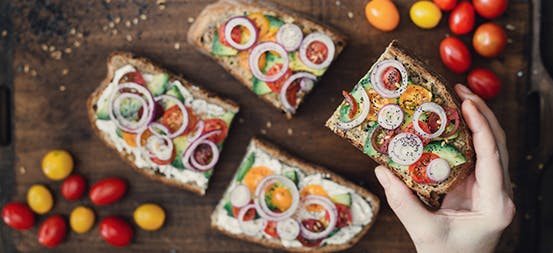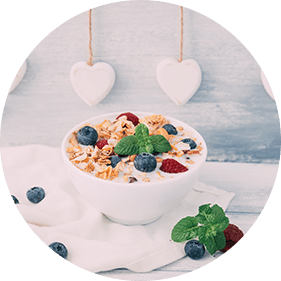Make Consuming These Types of Fiber a Daily Habit
Learn the difference between soluble and insoluble fiber.


Fiber is an important part of a balanced diet and promotes heart and digestive health. But did you know that there are actually two types of fiber, and it’s a good idea to consume both for a healthy diet?
Fiber Types and Health Benefits
There are two types of fiber—soluble and insoluble—that are required for a healthy diet.1
Soluble fiber dissolves in water and forms a gel that slows digestion.2 This type of fiber has numerous health benefits. Eating soluble fiber may make you feel more full, which may help with weight management. But not all soluble fibers are the same. Certain types of fiber have different benefits such as prebiotic effects, maintaining heart health, or even helping you feel fuller longer.
Insoluble fiber does not dissolve in water and cannot be digested.2 However, this type of fiber is important to health because it can help maintain regularity. Thus, insoluble fiber will help you feel comfortable throughout the day.
Sources of Fiber
Fortunately, many foods that are tasty to eat are also high in fiber. Vegetables, legumes, and whole grains are major sources of fiber. Often these foods contain both soluble and insoluble fiber.
Legumes are a great source of soluble fiber, especially beans. Fruits, vegetables, and seeds are also good sources of soluble fiber.1
Insoluble fiber is found in many types of produce and whole grains, such as the skin or peel of fruits and vegetables. Wheat and corn bran are also good sources of insoluble fiber.1
Fiber Supplements Can Help
Experts recommend that you eat 21 to 38 grams of fiber each day.3* Although you can take your fiber any time of the day, there is some evidence that fiber at breakfast promotes healthy weight loss.4 Having a breakfast with enough fiber is a good start to the day.
People who are busy and active may miss their daily requirements for fiber. Fortunately, there are fiber supplements available to maintain a balanced diet. Fiber supplements like Benefiber are made of soluble fiber, which have numerous health and weight maintenance benefits.
Fiber supplements, which dissolve in water, may be taken with non-carbonated beverages. This method is a convenient way to increase daily fiber intake. Fiber supplements taken along with a nutritious meals and snacks can offer a balanced diet.
*According to the Institute of Medicine, it is recommended that, in adults 50 or younger, women should consume 25 grams of fiber daily and men 38 grams. In adults 51 or older, women should consume 21 grams of fiber daily and men 30 grams.
Show References
- "Whole Grains and Fiber." American Heart Association. 11 Oct. 2016. Web. http://www.heart.org/HEARTORG/HealthyLiving/HealthyEating/HealthyDietGoals/Whole-Grains-and-Fiber_UCM_303249_Article.jsp#.WO-UNrbyuYV.
- "Dietary Fiber: Essential for a Healthy Diet." Mayo Clinic. 22 Sept. 2015. Web. http://www.mayoclinic.org/healthy-lifestyle/nutrition-and-healthy-eating/in-depth/fiber/art-20043983.
- "Fiber: Daily Recommendations for Adults." Mayo Clinic. 22 Sept. 2015. Web. http://www.mayoclinic.org/healthy-lifestyle/nutrition-and-healthy-eating/in-depth/fiber/art-20043983?pg=2.
- Hu, X., J. Gao, Q. Zhang, Y. Fu, K. Li, S. Zhu, and D. Li. "Soy Fiber Improves Weight Loss and Lipid Profile in Overweight and Obese Adults: A Randomized Controlled Trial." Molecular Nutrition & Food Research. U.S. National Library of Medicine, Dec. 2013. Web. https://www.ncbi.nlm.nih.gov/pubmed/23881774.
Nourish the Goodness Inside
Benefiber is an easy way to add fiber to your life.
$1.50 OFF BENEFIBER






